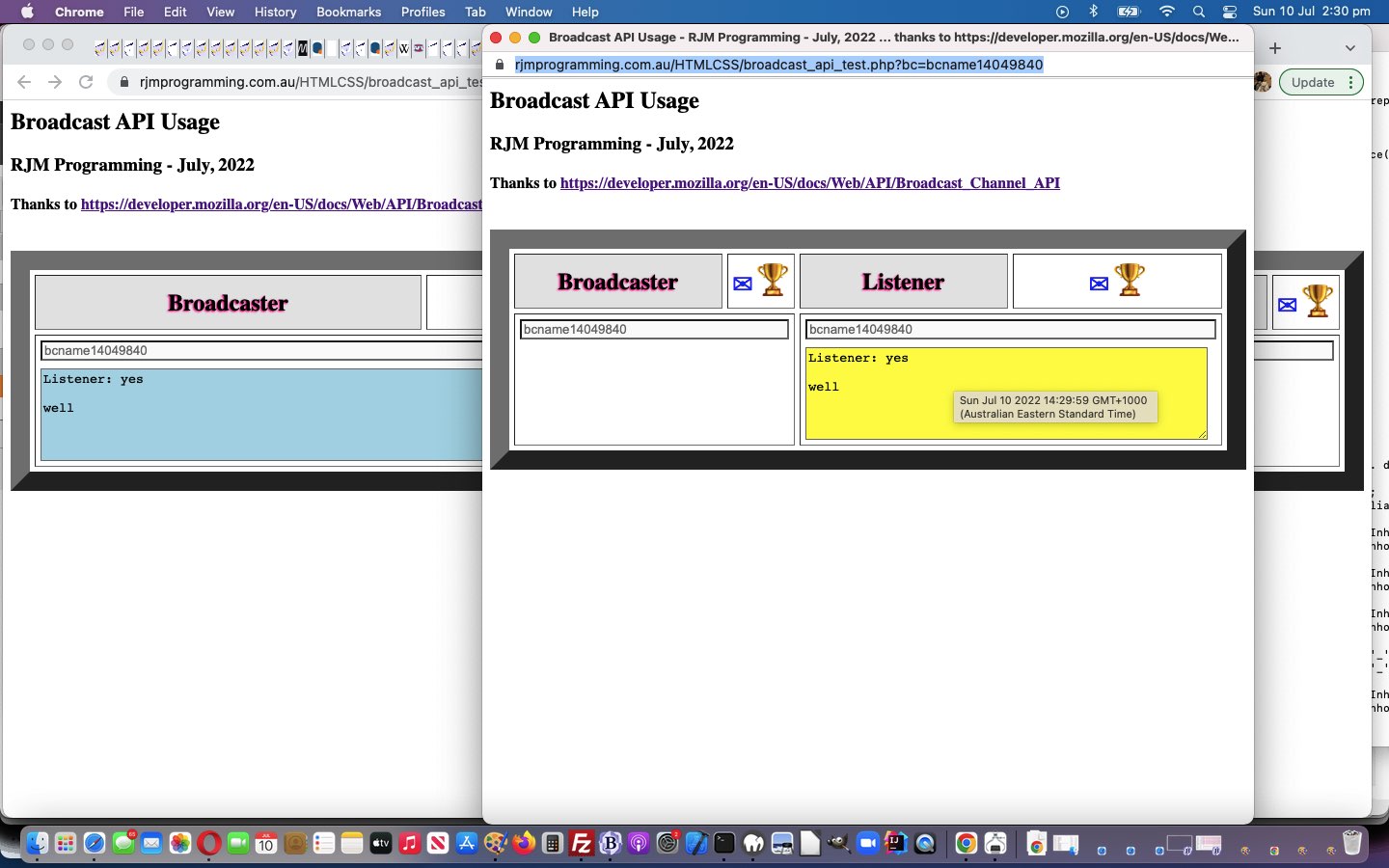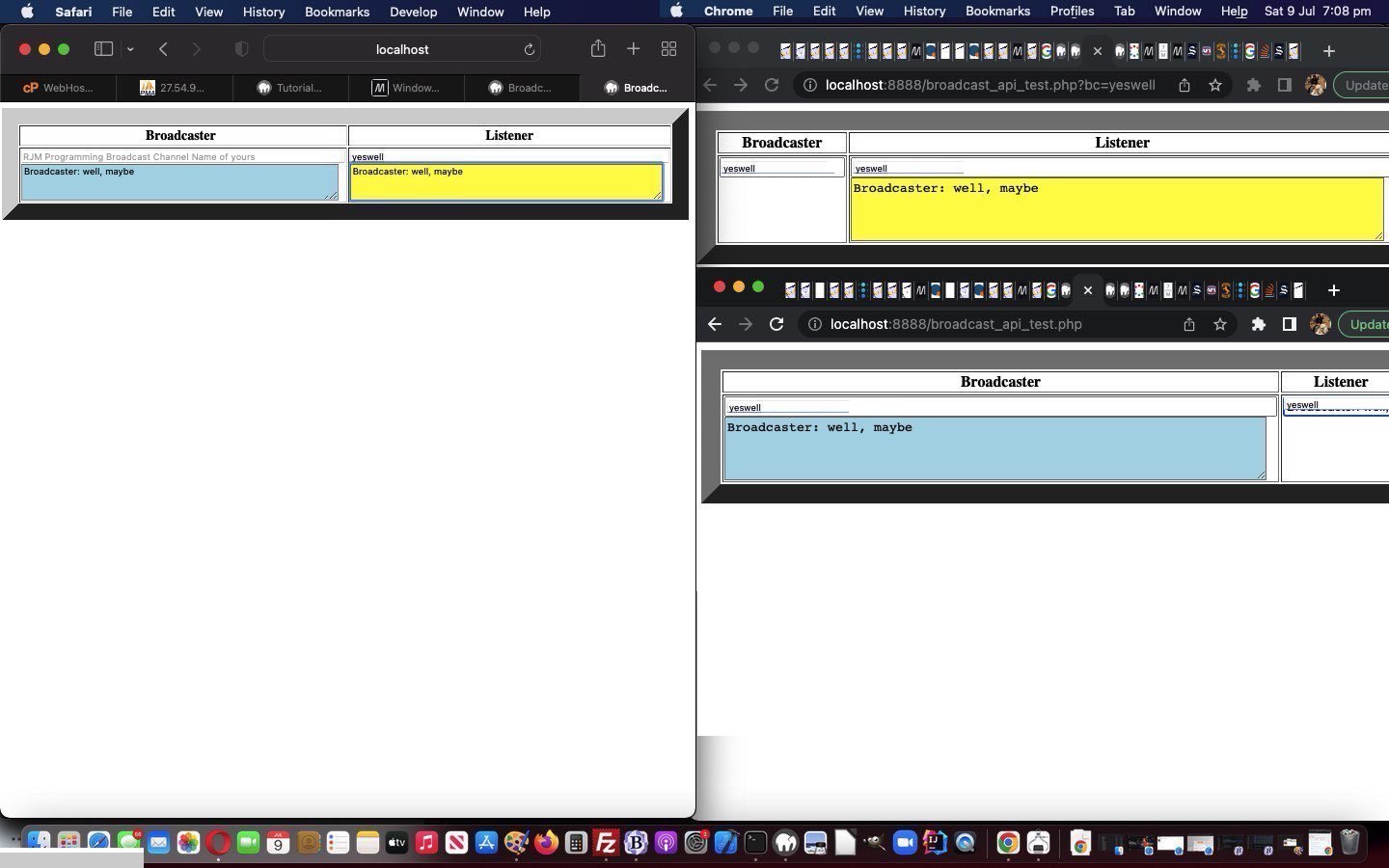
Broadcast Channel API Same Domain Sharing Tutorial
Yesterday’s getting us onto a “same domain” footing work with Broadcast Channel API Same Domain Tutorial has meant that it now makes sense for this PHP serverside web application to potentially spread its net wider to invite via …
… other users and collaborators, whether they want to be …
… into the mix of our changed broadcast_api_test.php Broadcasting web application using the Broadcast Channel API.
We use client based “a” link …
… prefixed URLs to achieve this, you may notice …
Previous relevant Broadcast Channel API Same Domain Tutorial is shown below.

Broadcast Channel API Same Domain Tutorial
Yesterday’s Broadcast Channel API Primer Tutorial‘s premise would have disappointed many as we outlined the restriction …
same device, same web browser
… with our HTML and Javascript client facing Broadcast Channel API web application.
But supposing we introduce “database” or “other data repository” thoughts? That can ease that restriction to then be, merely …
same domain
… which just means broadcasters and listeners access the “how we got there” “now PHP server facing” broadcast_api_test.php new Broadcasting web application incarnation.
But no formal “database” connections here. We make the PHP code itself be the “other data repository”, the new web application writing to itself, referencing the data of a particular Broadcast Channel in PHP records like …
<?php
// AM 09:46:06 Saturday 9th of July 2022: bcn=yeswell msg=TGlzdGVuZXI6IFdlbGwsCm9r
?>
… the message part base64_encoded to avoid line feeds and carriage returns of the textarea inputting elements.
Previous relevant Broadcast Channel API Primer Tutorial is shown below.

Broadcast Channel API Primer Tutorial
Broadcasting is a tried and trusted model of …
- information distribution
- entertainment distribution
… and if you add in “listeners who can respond” (perhaps named and the broadcaster can re-respond) you can add …
- feedback
- collaboration
- sharing
… into the mix. Well, today, we have a Broadcast Channel API idea where same device, same web browser users can subscribe to a Broadcast Channel and join into postMessage() inspired functionality of this ilk.
<html>
<head>
<title>Broadcast API Usage - RJM Programming - July, 2022 ... thanks to https://developer.mozilla.org/en-US/docs/Web/API/Broadcast_Channel_API</title>
</head>
<body>
<style>
td { vertical-align: top; }
#ta { width: 98%; background-color: yellow; }
#tab { width: 98%; background-color: lightblue; }
</style>
<table border=20 style='width:100%;'>
<tr><th contenteditable=true id=bname>Broadcaster</th><th contenteditable=true id=lname>Listener</th></tr>
<tr><td id=blist>
<input style='width:100%;' id=itab type=text placeholder='RJM Programming Broadcast Channel Name of yours' value='' onblur='newone(this);'></input>
<textarea id=tab placeholder='' value='' onblur='sthis(this);' rows=5 cols=80></textarea>
</td>
<td id=btextarea>
<input id=ita style='width:100%;' type=text placeholder='RJM Programming Broadcast Channel Name of broadcaster to subscribe to' value='' onblur='onenew(this);'></input>
<textarea id=ta onblur='sthis(this);' placeholder='' value='' rows=5 cols=80></textarea>
</td></tr>
</table>
<script type='text/javascript'>
var lastmsg='';
let ourbc=null;
let yourbc=null;
let pbc=null;
let bc=null;
var wois=null;
var ebc=location.search.split('bc=')[1] ? decodeURIComponent(location.search.split('bc=')[1].split('&')[0]).replace(/\+/g,' ') : "";
if (ebc.trim() != '') {
//const bc=null;
document.getElementById('itab').placeholder=ebc;
document.getElementById('ita').placeholder=ebc;
document.getElementById('itab').value='';
document.getElementById('ita').value='';
document.getElementById('itab').onblur=function(event) { event.target.value=ebc; }
document.getElementById('ita').onblur=function(event) { event.target.value=ebc; }
document.getElementById('itab').setAttribute('readonly',true);
document.getElementById('tab').setAttribute('readonly',true);
document.getElementById('tab').style.display='none';
yourbc = new BroadcastChannel(ebc);
yourbc.onmessage = event => {
if (minussc(event.data) != lastmsg) {
//alert('in with msg=' + event.data);
//document.getElementById('ta').value+=String.fromCharCode(10) + event.data.replace(lastmsg, '');
document.getElementById('ta').value=String.fromCharCode(10) + event.data; //.replace(lastmsg, '');
document.getElementById('ta').title='' + new Date();
document.getElementById('ta').rows='' + oureval(3 + eval('' + document.getElementById('ta').rows));
document.getElementById('tab').rows='' + oureval(3 + eval('' + document.getElementById('tab').rows));
if (yourbc) {
//yourbc.postMessage(document.getElementById('lname').innerHTML + ': ' + minussc(event.data)); //.replace(lastmsg, ''));
yourbc.postMessage(event.data); //.replace(lastmsg, ''));
window.opener.andback(); // wois.focus();
}
lastmsg=minussc(event.data);
}
};
wois=window.opener;
}
function andback() {
//alert('Am back');
window.focus();
}
function oureval(inv) {
var tabi=document.getElementById('tab').value.split(String.fromCharCode(10));
var tai=document.getElementById('ta').value.split(String.fromCharCode(10));
return Math.max(eval(2 + eval('' + tabi.length)), eval(2 + eval('' + tai.length)));
}
function newone(iv) {
if (iv.value.trim() != '') {
// Connection to a broadcast channel
//if (ourbc) {
// ourbc.close();
//}
//const bc = new BroadcastChannel(iv.value);
bc = new BroadcastChannel(iv.value);
pbc=bc;
ourbc=bc;
document.getElementById('ita').setAttribute('readonly',true);
document.getElementById('ta').setAttribute('readonly',true);
document.getElementById('ta').style.display='none';
ebc=iv.value;
document.getElementById('itab').placeholder=ebc;
document.getElementById('ita').placeholder=ebc;
document.getElementById('itab').value='';
document.getElementById('ita').value='';
document.getElementById('itab').onblur=function(event) { event.target.value=ebc; }
document.getElementById('ita').onblur=function(event) { event.target.value=ebc; }
bc.onmessage = event => {
if (minussc(event.data) != lastmsg) {
//document.getElementById('tab').value+=String.fromCharCode(10) + event.data.replace(lastmsg, '');
document.getElementById('tab').value=String.fromCharCode(10) + event.data; //.replace(lastmsg, '');
document.getElementById('tab').title='' + new Date();
document.getElementById('ta').rows='' + oureval(3 + eval('' + document.getElementById('ta').rows));
document.getElementById('tab').rows='' + oureval(3 + eval('' + document.getElementById('tab').rows));
if (bc) {
//bc.postMessage(document.getElementById('bname').innerHTML + ': ' + minussc(event.data)); //.replace(lastmsg, ''));
bc.postMessage(event.data); //.replace(lastmsg, ''));
wois.focus();
}
lastmsg=minussc(event.data);
}
};
wois=window.open(document.URL.split('#')[0].split('?')[0] + '?bc=' + encodeURIComponent(iv.placeholder), '_blank');
}
}
function onenew(iv) {
yourbc = new BroadcastChannel(iv.value);
yourbc.onmessage = event => {
if (minussc(event.data) != lastmsg) {
//document.getElementById('tab').value+=String.fromCharCode(10) + event.data.replace(lastmsg, '');
document.getElementById('tab').value=String.fromCharCode(10) + event.data; //.replace(lastmsg, '');
document.getElementById('tab').title='' + new Date();
document.getElementById('ta').rows='' + oureval(3 + eval('' + document.getElementById('ta').rows));
document.getElementById('tab').rows='' + oureval(3 + eval('' + document.getElementById('tab').rows));
if (ourbc) {
//ourbc.postMessage(document.getElementById('bname').innerHTML + ': ' + minussc(event.data)); //.replace(lastmsg, ''));
ourbc.postMessage(event.data); //.replace(lastmsg, ''));
wois.focus();
}
lastmsg=minussc(event.data);
}
};
}
function minussc(insa) {
if (insa.indexOf(': ') != -1) {
return insa.replace(insa.split(': ')[0] + ': ','');
}
return insa;
}
function sthis(iv) {
if (iv.value.trim() != '') {
if (yourbc && !pbc) {
yourbc.postMessage(document.getElementById('lname').innerHTML + ': ' + minussc(iv.value));
document.getElementById('ta').rows='' + oureval(3 + eval('' + document.getElementById('ta').rows));
document.getElementById('tab').rows='' + oureval(3 + eval('' + document.getElementById('tab').rows));
iv.placeholder+=String.fromCharCode(10) + iv.value;
iv.value='';
} else if (bc) {
//alert('at broadcaster with msg=' + iv.value);
//bc=newone(document.getElementById('itab'));
bc.postMessage(document.getElementById('bname').innerHTML + ': ' + minussc(iv.value));
document.getElementById('ta').rows='' + oureval(3 + eval('' + document.getElementById('ta').rows));
document.getElementById('tab').rows='' + oureval(3 + eval('' + document.getElementById('tab').rows));
iv.placeholder+=String.fromCharCode(10) + iv.value;
iv.value='';
}
}
}
</script>
</body>
</html>
… as a first draft “proof of concept” broadcast_api_test.html Broadcast API web application you can try for yourself.
If this was interesting you may be interested in this too.
If this was interesting you may be interested in this too.
If this was interesting you may be interested in this too.



Broadcast Channel API Same Domain Sharing Tutorial
Broadcast Channel API Same Domain Sharing Tutorial
Yesterday’s getting us onto a “same domain” footing work with Broadcast Channel API Same Domain Tutorial has meant that it now makes sense for this PHP serverside web application to potentially spread its net wider to invite via …
… other users and collaborators, whether they want to be …
… into the mix of our changed broadcast_api_test.php Broadcasting web application using the Broadcast Channel API.
We use client based “a” link …
… prefixed URLs to achieve this, you may notice …
Previous relevant Broadcast Channel API Same Domain Tutorial is shown below.
Broadcast Channel API Same Domain Tutorial
Yesterday’s Broadcast Channel API Primer Tutorial‘s premise would have disappointed many as we outlined the restriction …
… with our HTML and Javascript client facing Broadcast Channel API web application.
But supposing we introduce “database” or “other data repository” thoughts? That can ease that restriction to then be, merely …
… which just means broadcasters and listeners access the “how we got there” “now PHP server facing” broadcast_api_test.php new Broadcasting web application incarnation.
But no formal “database” connections here. We make the PHP code itself be the “other data repository”, the new web application writing to itself, referencing the data of a particular Broadcast Channel in PHP records like …
<?php
// AM 09:46:06 Saturday 9th of July 2022: bcn=yeswell msg=TGlzdGVuZXI6IFdlbGwsCm9r
?>
… the message part base64_encoded to avoid line feeds and carriage returns of the textarea inputting elements.
Previous relevant Broadcast Channel API Primer Tutorial is shown below.
Broadcast Channel API Primer Tutorial
Broadcasting is a tried and trusted model of …
… and if you add in “listeners who can respond” (perhaps named and the broadcaster can re-respond) you can add …
… into the mix. Well, today, we have a Broadcast Channel API idea where same device, same web browser users can subscribe to a Broadcast Channel and join into postMessage() inspired functionality of this ilk.
<html>
<head>
<title>Broadcast API Usage - RJM Programming - July, 2022 ... thanks to https://developer.mozilla.org/en-US/docs/Web/API/Broadcast_Channel_API</title>
</head>
<body>
<style>
td { vertical-align: top; }
#ta { width: 98%; background-color: yellow; }
#tab { width: 98%; background-color: lightblue; }
</style>
<table border=20 style='width:100%;'>
<tr><th contenteditable=true id=bname>Broadcaster</th><th contenteditable=true id=lname>Listener</th></tr>
<tr><td id=blist>
<input style='width:100%;' id=itab type=text placeholder='RJM Programming Broadcast Channel Name of yours' value='' onblur='newone(this);'></input>
<textarea id=tab placeholder='' value='' onblur='sthis(this);' rows=5 cols=80></textarea>
</td>
<td id=btextarea>
<input id=ita style='width:100%;' type=text placeholder='RJM Programming Broadcast Channel Name of broadcaster to subscribe to' value='' onblur='onenew(this);'></input>
<textarea id=ta onblur='sthis(this);' placeholder='' value='' rows=5 cols=80></textarea>
</td></tr>
</table>
<script type='text/javascript'>
var lastmsg='';
let ourbc=null;
let yourbc=null;
let pbc=null;
let bc=null;
var wois=null;
var ebc=location.search.split('bc=')[1] ? decodeURIComponent(location.search.split('bc=')[1].split('&')[0]).replace(/\+/g,' ') : "";
if (ebc.trim() != '') {
//const bc=null;
document.getElementById('itab').placeholder=ebc;
document.getElementById('ita').placeholder=ebc;
document.getElementById('itab').value='';
document.getElementById('ita').value='';
document.getElementById('itab').onblur=function(event) { event.target.value=ebc; }
document.getElementById('ita').onblur=function(event) { event.target.value=ebc; }
document.getElementById('itab').setAttribute('readonly',true);
document.getElementById('tab').setAttribute('readonly',true);
document.getElementById('tab').style.display='none';
yourbc = new BroadcastChannel(ebc);
yourbc.onmessage = event => {
if (minussc(event.data) != lastmsg) {
//alert('in with msg=' + event.data);
//document.getElementById('ta').value+=String.fromCharCode(10) + event.data.replace(lastmsg, '');
document.getElementById('ta').value=String.fromCharCode(10) + event.data; //.replace(lastmsg, '');
document.getElementById('ta').title='' + new Date();
document.getElementById('ta').rows='' + oureval(3 + eval('' + document.getElementById('ta').rows));
document.getElementById('tab').rows='' + oureval(3 + eval('' + document.getElementById('tab').rows));
if (yourbc) {
//yourbc.postMessage(document.getElementById('lname').innerHTML + ': ' + minussc(event.data)); //.replace(lastmsg, ''));
yourbc.postMessage(event.data); //.replace(lastmsg, ''));
window.opener.andback(); // wois.focus();
}
lastmsg=minussc(event.data);
}
};
wois=window.opener;
}
function andback() {
//alert('Am back');
window.focus();
}
function oureval(inv) {
var tabi=document.getElementById('tab').value.split(String.fromCharCode(10));
var tai=document.getElementById('ta').value.split(String.fromCharCode(10));
return Math.max(eval(2 + eval('' + tabi.length)), eval(2 + eval('' + tai.length)));
}
function newone(iv) {
if (iv.value.trim() != '') {
// Connection to a broadcast channel
//if (ourbc) {
// ourbc.close();
//}
//const bc = new BroadcastChannel(iv.value);
bc = new BroadcastChannel(iv.value);
pbc=bc;
ourbc=bc;
document.getElementById('ita').setAttribute('readonly',true);
document.getElementById('ta').setAttribute('readonly',true);
document.getElementById('ta').style.display='none';
ebc=iv.value;
document.getElementById('itab').placeholder=ebc;
document.getElementById('ita').placeholder=ebc;
document.getElementById('itab').value='';
document.getElementById('ita').value='';
document.getElementById('itab').onblur=function(event) { event.target.value=ebc; }
document.getElementById('ita').onblur=function(event) { event.target.value=ebc; }
bc.onmessage = event => {
if (minussc(event.data) != lastmsg) {
//document.getElementById('tab').value+=String.fromCharCode(10) + event.data.replace(lastmsg, '');
document.getElementById('tab').value=String.fromCharCode(10) + event.data; //.replace(lastmsg, '');
document.getElementById('tab').title='' + new Date();
document.getElementById('ta').rows='' + oureval(3 + eval('' + document.getElementById('ta').rows));
document.getElementById('tab').rows='' + oureval(3 + eval('' + document.getElementById('tab').rows));
if (bc) {
//bc.postMessage(document.getElementById('bname').innerHTML + ': ' + minussc(event.data)); //.replace(lastmsg, ''));
bc.postMessage(event.data); //.replace(lastmsg, ''));
wois.focus();
}
lastmsg=minussc(event.data);
}
};
wois=window.open(document.URL.split('#')[0].split('?')[0] + '?bc=' + encodeURIComponent(iv.placeholder), '_blank');
}
}
function onenew(iv) {
yourbc = new BroadcastChannel(iv.value);
yourbc.onmessage = event => {
if (minussc(event.data) != lastmsg) {
//document.getElementById('tab').value+=String.fromCharCode(10) + event.data.replace(lastmsg, '');
document.getElementById('tab').value=String.fromCharCode(10) + event.data; //.replace(lastmsg, '');
document.getElementById('tab').title='' + new Date();
document.getElementById('ta').rows='' + oureval(3 + eval('' + document.getElementById('ta').rows));
document.getElementById('tab').rows='' + oureval(3 + eval('' + document.getElementById('tab').rows));
if (ourbc) {
//ourbc.postMessage(document.getElementById('bname').innerHTML + ': ' + minussc(event.data)); //.replace(lastmsg, ''));
ourbc.postMessage(event.data); //.replace(lastmsg, ''));
wois.focus();
}
lastmsg=minussc(event.data);
}
};
}
function minussc(insa) {
if (insa.indexOf(': ') != -1) {
return insa.replace(insa.split(': ')[0] + ': ','');
}
return insa;
}
function sthis(iv) {
if (iv.value.trim() != '') {
if (yourbc && !pbc) {
yourbc.postMessage(document.getElementById('lname').innerHTML + ': ' + minussc(iv.value));
document.getElementById('ta').rows='' + oureval(3 + eval('' + document.getElementById('ta').rows));
document.getElementById('tab').rows='' + oureval(3 + eval('' + document.getElementById('tab').rows));
iv.placeholder+=String.fromCharCode(10) + iv.value;
iv.value='';
} else if (bc) {
//alert('at broadcaster with msg=' + iv.value);
//bc=newone(document.getElementById('itab'));
bc.postMessage(document.getElementById('bname').innerHTML + ': ' + minussc(iv.value));
document.getElementById('ta').rows='' + oureval(3 + eval('' + document.getElementById('ta').rows));
document.getElementById('tab').rows='' + oureval(3 + eval('' + document.getElementById('tab').rows));
iv.placeholder+=String.fromCharCode(10) + iv.value;
iv.value='';
}
}
}
</script>
</body>
</html>
… as a first draft “proof of concept” broadcast_api_test.html Broadcast API web application you can try for yourself.
If this was interesting you may be interested in this too.
If this was interesting you may be interested in this too.
If this was interesting you may be interested in this too.